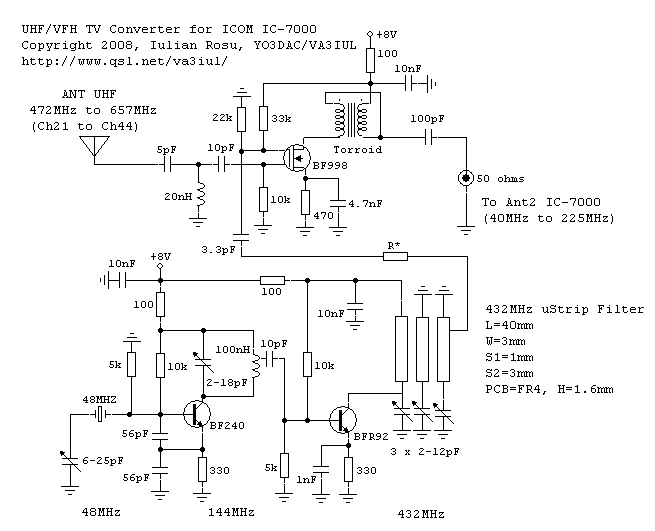
UHF to VHF TV Converter for ICOM IC-7000
Iulian Rosu, YO3DAC / VA3IUL
The new transceiver from ICOM, IC-7000, have TV screen receive capability which is a nice future. Unfortunately ICOM designed the TV to receive only the VHF bands from 40MHz to 225MHz (185MHz span).
The TV converter presented below allows the user to receive the UHF TV channels from 472MHz to 657MHz (Ch22 to Ch44).
The received UHF signal goes through a high-pass filter to Gate1 of the down-conversion mixer which is a dual-gate MOSFET transistor BF998. The mixer has at the output a wideband torroid (2 x 10 turns) allowing using a 50 ohms coaxial cable between converter and Ant2 of IC-7000.
On Gate2 of the mixer is injected the 432MHz Local Oscillator signal. The level of the LO could be adjusted with R* for best performance and less spurious at the output.
The Local Oscillator uses a frequency multiplier. It is based on a 48MHz crystal which is multiplied by three, up to 144MHz (BF240). Then the 144MHz signal is multiplied again by three, up to 432MHz (BFR92). The 432MHz signal needs to be clean of harmonics or sub-harmonics. A micro-strip band-pass filter is used to clean up the signal. A low impedance tapped output is used to pick-up the LO signal to send it to the mixer.
Because this kind of LO use frequency multipliers, generates a lot of unwanted spurious (which can go to the mixer). So, is hardly recommended to be very well shielded in a metal case.
Usually the UHF TV channels goes up to Ch60 (783MHz), which anyway is used very rare. If you want to receive channels above Ch44 (657MHz) you can use a different crystal instead 48MHz (which anyway is not mandatory to be exactly 48MHz).
For example if you use a 53MHz overtone crystal (a very common crystal in the old two-way VHF radios), the down-converted receive band will be between 517MHz to 702MHz (Ch27 to Ch50). In this case, the LO output micro-strip band-pass filter needs to be slightly adjusted.
